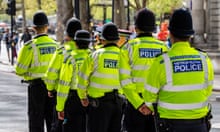Police are far more likely to use a Taser electrical weapon against black people due to structural and institutional racism rather than the views of individual officers, a new report says.
It follows the biggest ever academic study of the police’s use of the weapon, which found officers increasingly see it as a tool that can get suspects to comply, rather than a potentially lethal item.
Communities see its use as humiliating and traumatic and the report, which was funded by the police, says radical reforms are needed to training.
The Taser electrical weapon has been linked to several deaths in the UK. Officials insist it is safe for widespread use but some campaigners claim it should be curtailed or banned.
The study was conducted by researchers from University College London, Keele, Exeter and Staffordshire universities.
While some officers see black people as more threatening and thus use a Taser electrical weapon, the study said the biggest reasons for the racial disparity was not decisions by individual officers.
How and where officers were deployed by their chiefs were the key reasons.
Officers are more frequently deployed into higher crime areas, which tend to have acute levels of poverty and higher ethnic minority populations.
The report says: “Our study suggests it may be a combination of societal issues and institutional policing priorities, policies and practices which are systematically and disproportionately affecting black and other ethnic minority communities in deprived neighbourhoods relative to the populations of more wealthy surrounding, predominantly white areas.
“In other words, our study supports the idea that the patterns of ethnic disproportionality evident in the UK Home Office statistics cannot be explained solely or even primarily at the level of individual officer behaviour or psychology because they are an outcome of an interaction between structural and institutional racism.”
The weapon fires an electric current of 50,000 volts and is meant to temporarily incapacitate a suspect by interfering with the body’s neuromuscular system.
Its use has grown, it was deployed just under 17,000 times in 2017-18, by 2021-22 this had grown to 34,276 uses. The number of officers issued with a Taser electrical weapon has also increased.
Use of the weapon in official statistics does not necessarily mean it is fired at a suspect. The official figures include where it is unholstered and a suspect threatened with it, and also where a suspect is “red dotted”, where the red laser used to aim the device is visible to a suspect, often leading them to obey an officer’s commands. It is fired in about a tenth of incidents.
Inquest juries have found that its use played a part in the deaths of Jordan Begley in 2013 in Manchester, and the death of Marc Cole in 2017 in Falmouth. In 2021 a police officer was convicted of the manslaughter of former premiership footballer Dalian Atkinson having kicked him in the head while he was on the ground, and also having fired the weapon into him for 33 seconds – longer than recommended.
The report was commissioned by the College of Policing, which sets standards in law enforcement.
The report found that officers need to be taught when not to use a Taser electrical weapon and deploy de-escalation skills instead: “Our data suggested an institutionalisation of Taser had occurred such that the question for control room staff had become not ‘can we justify sending Taser officers’ but, rather, ‘can we justify not sending Taser officers’. .”
Report co-author Dr Ben Bradford said: “A central issue … will be exploring whether and how police can change policy and practice to alleviate ethnic disproportionality in Taser use. If this is not possible, then there must be fundamental questions about continued use of the weapon, at least in its current form.”
Chief constable Lucy D’Orsi, who speaks for the NPCC on use of the weapon, said: “In 2019-20 black people were eight times more likely to have it used on them. Whilst figures from 2022-23 stats have shown a reduction to 4.2 times more likely, it is vital that we question why that is and take action.
“We welcome the findings of the report and are committed to thoroughly reviewing the content so that we can make appropriate changes to have a positive impact on the lives of black people.”









